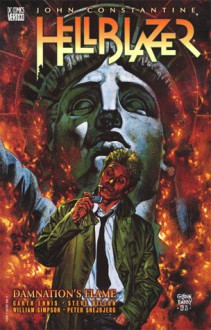(For mature audiences.) Garth Ennis, who is also known for his popular Vertigo series Preacher, always manages to weave together the dark and horrific with the commonplace to epitomize the graphic-novel medium. John Constantine, Hellblazer: Damnation's Flame collects issues 72 to 77 of the DC...
show more
(For mature audiences.) Garth Ennis, who is also known for his popular Vertigo series Preacher, always manages to weave together the dark and horrific with the commonplace to epitomize the graphic-novel medium. John Constantine, Hellblazer: Damnation's Flame collects issues 72 to 77 of the DC Comics series in a volume that is really composed of four short stories. In the primary tale of the collection, Constantine, a trench-coated magus, wanders the streets of New York City. Reeling from the loss of his lover, Kit, he literally falls under the spell of a minor magician. Constantine's physical body is abused in a homeless shelter while his soul travels the barren roads of a tiny slice of hell. His companion on the journey is President John F. Kennedy, who has been trapped in this limbo world since moments after his assassination. The site of the ever-suffering Kennedy will be difficult for many readers, but through Constantine's interactions with the President on their journey to hell's White House, Ennis punctures many of the myths that have shaped late-20th-century America. Kennedy is shown to be all too human, and the ruler of this hell, a ghostly Abraham Lincoln, reveals himself as the only bigger myth-figure able to free Kennedy with a heavy dose of reality. "Act of Union," the second story, flashes back to 1980 with a quotidian narrative about Kit and Constantine's first meeting. This is a small, beautiful story that demonstrates Ennis's impressive range as a writer (especially when compared to the bloody opening selection). William Simpson's sketchy artwork perfectly captures the mood of Ennis's word balloons. "Confessions of an Irish Rebel" is another tale with a smaller and less mystical scope than the opening, but, as Constantine becomes mixed up with his old friend Dublin, things take a turn toward gore and violence. Finally, "And the Crowd Goes Wild" is actually a frame narrative, a story told in a bar that again moves back over a decade, to the night Chas Chandler gave John a ride in his cab and ended up being involved in a terrifying case that touched hell itself. --Patrick O'Kelley
show less

